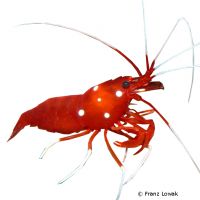Blood Red Fire Shrimp (Lysmata debelius)
| Blood Red Fire Shrimp Lysmata debelius | |
|---|---|
| Name | Blood Red Fire Shrimp |
| Name Lat. | Lysmata debelius |
| Family | Broken-back Shrimps |
| Family lat. | Hippolytidae |
| Order | Decapoda |
| Order lat. | Decapoda |
| Origin | Indo-Pacific |
| Diet | Carnivore |
| pH | 8.1-8.4 |
| Hardness | 6-10 °KH |
| Lighting | Medium |
| Current | Moderate |
| Behavior | Peaceful |
| Keeping | Pair |
| Care Level | Moderate |
| Life Span | 3-5 years |
| Protection | No |
| Metric Units | |
| Size | 5 cm |
| Temperature | 22-27 °C |
| Salinity | 33-36 ‰ |
| Aquarium | 100 l |
| US Units | |
| Size | 2" |
| Temperature | 70-81 °F |
| Salinity | 1.020-1.025 sg |
| Aquarium | 25 gal |
Distribution and habitat
The distribution area of Lysmata debelius is the Indian and Pacific Ocean, from the Maldives over Indonesia to the Fiji Islands. They live mostly hidden on coral reefs, in cave entrances, reef crevices and under overhangs.
Maintenance
They need a well structured aquarium with a reef structure (crevices, caves, shelters, overhangs), with live rocks that they can graze on (small crustaceans) and that act like a biological filter.
Only substrates rich in lime and free of heavy metals may be used as substrate. Filters, skimmers and heaters are necessary to ensure water quality, as well as pumps to simulate tides, swells and bottom currents. The lighting must correspond to the species-appropriate day-night rhythm of the animals.
| Salinity: 33-36 ‰ | pH value: 8.1-8.4 |
| Carbonate hardness: 6-10 °KH | Nitrate content: 2-8 mg/l |
| calcium content: 400-450 mg/l | Nitrite content: 0.0-0.05 mg/l |
| Magnesium content: 1.250-1.350 mg/l | phosphate content: 0.01-0.1 mg/l |
Regular addition of trace elements, especially iodine, is recommended. For salinity, an average value should be aimed for, which may only vary slightly by +/- 0.5 ‰. Ammonia and ammonium must not be measurable. Special attention shall be paid to consistently good water quality and water values.
Diet
In nature they feed on plankton, growth and small crustaceans as well as skin particles and parasites, which they remove from the host fish. In a community tank, special feeding is not essential, as they partake of fish food (small mysis, krill, artemia, bosmids, dry food, etc.) in addition to their "cleaning" activity. They also eat small red bristle worms. Once or twice a week, phyto- and zooplankton, available as ready-made food in specialized stores, should be offered.
Regular and varied feeding promotes health and increases resistance.
Behaviour and compatibility
They should be kept in pairs or in a group and they defend their territory. Socialization with Stenopus hispidus and Lysmata amboinensis is not recommended, as they are always suppressed by them and stay hidden.
A socialization with fish and invertebrates, by which they are not regarded as food, is very well possible.
Reproduction and breeding
They do not appear to be simultaneous hermaphrodites and determine their sex at an early stage of development. External sexual characteristics are not known.
The female carries the eggs on her pleopods (webbed feet) for about 14 days and supplies them with oxygen by movement (fanning). The free-swimming larvae feed on plankton such as brachionus (rotifers) and copepods (copepods).
Important
In nature, fish swim "cleaning stations" and challenge shrimp to clean by slanting and spreading their fins. In the aquarium, however, this behavior occurs very rarely.
If the water values are not appropriate (e.g. iodine content), moulting problems may occur.
Special care is required when placing them in the aquarium. They are very sensitive to different water conditions. Newly introduced animals must be accustomed slowly to the water in the aquarium.
If different species are kept together, care must be taken to ensure that fish and invertebrates match each other in terms of water quality and temperature requirements, as well as their social behavior, and that the setup meets the ecological needs of all species kept together
Further literature can be found in your pet store.
References
Text: Werner Winter; Image: Franz Lowak
Source: KNOP (2013): Lexikon der Meeresaquaristik, Natur und Tier Verlag; ENGELMANN & LANGE (2011): Zootierhaltung - Tiere in menschlicher Obhut: Wirbellose, Verlag Harri Deutsch
